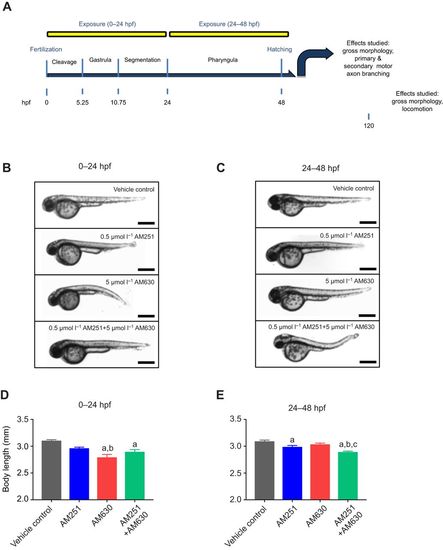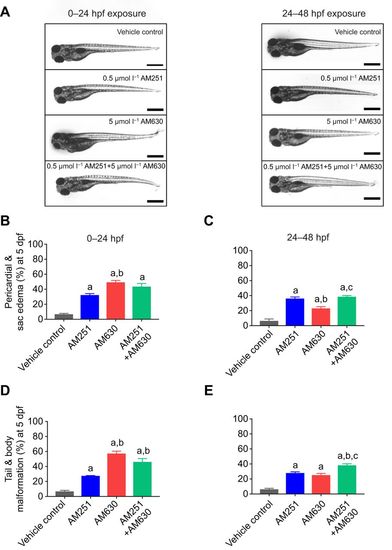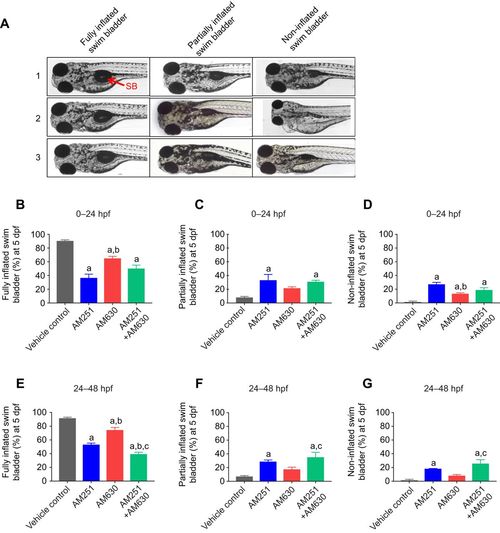- Title
-
CB1 and CB2 receptors play differential roles in early zebrafish locomotor development
- Authors
- Sufian, M.S., Amin, M.R., Kanyo, R., Allison, W.T., Ali, D.W.
- Source
- Full text @ J. Exp. Biol.
|
|
|
Effect of the endocannabinoid receptor antagonists, AM251 and AM630 on morphological development in 5 dpf zebrafish larva. (A) Incidence of pericardial edema and yolk sac edema in 5 dpf larvae when treated with AM251 and AM630 in the first and second 24 h of development. Scale bars: 0.7 mm. (B,D) Rates of pericardial and yolk sac edema and tail and body malformation in 5 dpf larvae treated with AM251 and AM630 in the first 24 h of development (n=62, 56, 51 and 58 for vehicle control, 0.5 µmol l−1 AM251, 5 µmol l−1 AM630 and 0.5 µmol l−1 AM251+5 µmol l−1AM630, respectively). (C,E) Rates of pericardial and yolk sac edema and tail and body malformation in 5 dpf larvae treated with AM251 and AM630 in the second 24 h of development (24–48 hpf) (n=74, 56, 62 and 64 for vehicle control, 0.5 µmol l−1 AM251, 5 µmol l−1 AM630 and 0.5 µmol l−1 AM251+5 µmol l−1 AM630, respectively). Data are presented as means±s.e.m. aSignificantly different from vehicle control, P<0.05; bsignificantly different from 0.5 µmol l−1AM251, P<0.05; csignificantly different from 5 µmol l−1 AM630, P<0.05 (one-way ANOVA followed by Tukey’s post hoc multiple comparisons test). |
|
Effect of the endocannabinoid receptor antagonists AM251 and AM630 on development and inflation of 5 dpf larval zebrafish swim bladders. (A) AM251 and AM630 treatments at the early stage either from 0 to 24 hpf or 24 to 48 hpf showed fully inflated to partial or non-inflated swim bladder (SB; red arrow) development in zebrafish larvae observed at 5 dpf. Representative images of three different fish, labelled 1, 2 and 3, show fully inflated, partially inflated or non-inflated swim bladders in larvae. (B–G) Rates of swim bladder inflation at 0–24 hpf (B–D: n=73, 59, 57 and 58 for vehicle control, 0.5 µmol l−1 AM251, 5 µmol l−1 AM630 and 0.5 µmol l−1AM251+5 µmol l−1 AM630 treatments, respectively) and at 24–48 hpf (E–G: n=78, 58, 61 and 60 for vehicle control, 0.5 µmol l−1 AM251, 5 µmol l−1 AM630 and 0.5 µmol l−1 AM251+5 µmol l−1AM630 treatments, respectively). Data are presented as means±s.e.m. aSignificantly different from vehicle control, P<0.05; bsignificantly different from 0.5 µmol l−1 AM251, P<0.05; csignificantly different from 5 µmol l−1 AM630, P<0.05 (one-way ANOVA followed by Tukey’s post hoc multiple comparisons test). |



